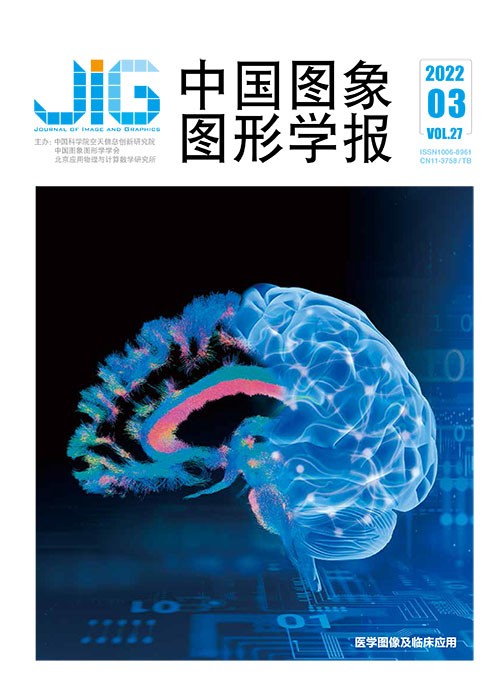
COVID-19肺部CT图像多尺度编解码分割
摘 要
目的 新型冠状病毒肺炎(corona virus disease 2019,COVID-19)患者肺部计算机断层扫描(computed tomography,CT)图像具有明显的病变特征,快速而准确地从患者肺部CT图像中分割出病灶部位,对COVID-19患者快速诊断和监护具有重要意义。COVID-19肺炎病灶区域复杂多变,现有方法分割精度不高,且对假阴性的关注不够,导致分割结果往往具有较高的特异度,但灵敏度却很低。方法 本文提出了一个基于深度学习的多尺度编解码网络(MED-Net (multiscale encode decode network)),该网络采用资源利用率高、计算速度快的HarDNet68(harmonic densely connected network)作为主干,它主要由5个harmonic dense block (HDB)组成,首先通过5个空洞空间卷积池化金字塔(atrous spatial pyramid pooling,ASPP)对HarDNet68的第1个卷积层和第1、3、4、5个HDB提取多尺度特征。接着在并行解码器(paralleled partial decoder,PPD)基础上设计了一个多尺度的并行解码器(multiscale parallel partial decoder,MPPD),通过对3个不同感受野的分支进行解码,解决了编码器部分的信息丢失及小病灶分割困难等问题。为了提升CT图像分割精度,降低网络学习难度,网络加入了深度监督机制,配合多尺度解码器,增加了对假阴性的关注,从而提高模型的灵敏度。结果 在COVID-19 CT segmentation数据集上对本文网络进行了测试。实验结果表明,MED-Net可以有效地应对数据集样本少,以及分割目标的纹理、尺寸和位置变异大等问题。在只有50幅训练图像和50幅测试图像的数据集上,分割结果的Dice系数为73.8%,灵敏度为77.7%,特异度为94.3%;与Inf-Net (lung infection segmentation deep network)网络相比,分别提升了8.21%、12.28%、7.76%。其中,Dice系数和灵敏度达到了目前基于该数据集相同划分方式的先进水平。结论 本文网络提高了COVID-19肺炎CT图像分割精确度,有效解决了数据集的数据量少、小病灶分割难度大等问题,具有全自动分割COVID-19肺炎CT图像的能力。
关键词
Multiscale codec network based CT image segmentation for human lung disease derived of COVID-19
Lu Qianjie, Bai Zhengyao, Fan Shenglan, Zhou Xue, Xu Zhu(School of Information Science and Engineering, Yunnan University, Kunming 650500, China) Abstract
Objective The corona virus disease 2019 (COVID-19), also known as severe acute respiratory syndrome coronavirus (SARS-CoV-2), has rapidly spread throughout the world as a result of the increased mobility of populations in a globalized world, wreaking havoc on people's daily lives, the global economy, and the global healthcare system. The novelty and dissemination speed of COVID-19 compelled researchers around the world to move quickly, using all resources and capabilities to analyse and characterize the novel coronavirus in terms of transmission routes and viral latency. Early and effective screening of COVID-19 patients and corresponding medical treatment, care and isolation to cut off the transmission route of the novel coronavirus are the key to prevent the spread of the epidemic. Due to the rapid infection of COVID-19, it is very important to screen COVID-19 threats based on precise segmenting lesions in lung CT images, which can be a low cost and quick response method nowadays. Rapid and accurate segmentation of coronavirus pneumonia CT images is of great significance for auxiliary diagnosis and patient monitoring. Currently, the main method for COVID-19 screening is the reverse transcription polymerase chain reaction like reverse transcription-polymerase chain reaction(RT-PCR) analysis. But, RT-PCR is time consuming to provide the diagnosis results, and the false negative rate is relatively high. Another effective method for COVID-19 screening is computed tomography (CT) technology. The CT scanning technology has high sensitivity and enhanced three-dimensional representation of infection visualization. Computed tomography (CT) has been used as an important method for the diagnosis and treatment of patients with COVID-19, the chest CT images of patients with COVID-19 mostly show multifocal, patchy, peripheral distribution, and ground glass opacity (GGO) which is mostly seen in the lower lobes of both lungs; a high degree of suspicion for novel coronavirus's infection can be obtained if more GGO than consolidation is found on CT images; therefore, detection of GGO in CT slices regions can provide clinicians with important information and help in the fight against COVID-19. The current analysis of COVID-19 pneumonia lesions has low segmentation accuracy and insufficient attention to false negatives. Method Our accurate segmentation model based on small data set. In view of the complexity and variability of the targeted area of COVID-19 pneumonia, we improved Inf-Net and proposed a multi-scale encoding and decoding network (MED-Net) based on deep learning method. The computational cost may be caused by multi-scale encoding and decoding. The network extends the encoder-decoder structure in FC-Net, in which the decoder part is on the left column; The middle column is atrous spatial pyramid pooling (ASPP) structure; The right column is a multi-scale parallel decoder which is based on the improvement of parallel partial decoder. In this network structure, HarDNet68 is adopted as the backbone in terms of high resource utilization and fast computing speed, which can be as a simplified version of DenseNet, reduces DenseNet based hierarchical connections to get cascade loss deduction. HardNet68 is mainly composed of five harmonious dense blocks (HDB). Based on 5 different scales, We extract multiscale features from the first convolution layer and the 5 HDB sequential steps of HarDNet68 via a five atrous spatial pyramid pooling (ASPP). Meanwhile, as a new decoding component, a multiscale parallel partial decoder (MPPD) is based on the parallel decoder (PPD), which can aggregate the features between different levels in parallel. By decoding the branches of three different receptive fields, we have dealt with information loss issues in the encoder part and the difficulty of small lesions segmentation. Our deep supervision mechanism has melted the multi-scale decoder into the true positive and true negative samples analyses, for improving the sensitivity of the model. Result Current COVID-19 CT Segmentation provides completed segmentation labels as a small data set. This research is improved based on Inf-Net, and the model structure is simple, the edge attention module(EA) is not introduced, and the reverse attention module(RA) is not quoted, only one MPPD is used to optimize the network stricture. The quantitative results show that MED-Net can effectively cope with the problems of fewer samples in the small dataset, the texture, size and position of the segmentation target vary greatly. On the data set with only 50 training images and 50 test images, the Dice coefficient is 73.8%, the sensitivity is 77.7%, and the specificity is 94.3%. Compared with the previous work, it has increased by 8.21%, 12.28% and 7.76% respectively. Among them, Dice coefficient and sensitivity have reached the most advanced level based on the same division mode of this data set. Simultaneously the qualitative results address that the segmentation result of the proposed model is closer to ground-truth in this experiment. We also conducted ablation experiments, that the use of MPPD has obvious effects to deal with small lesions area segmentation and improving segmentation accuracy. Conclusion Our analysis shows that the proposed method can effectively improve the segmentation accuracy of the lesions in the CT images of the COVID-19 derived lungs disease. Our segmentation accuracy of MED-Net is qualified. The quantitative and qualitative results demonstrate that MED-Net is relatively effective in controlling edges and details, which can capture rich context information, and improve sensitivity. MED-Net can also effectively resolve the small lesions segmentation issue. For COVID-19 CT Segmentation data set, it has several of qualified evaluation indicators based on end-to-end learning. The potential of automatic segmentation of COVID-19 pneumonia is further facilitated.
Keywords
corona virus disease 2019(COVID-19) CT image segmentation multi-scale codec depth monitoring mechanism small lesions segmentation
|



 中国图象图形学报 │ 京ICP备05080539号-4 │ 本系统由
中国图象图形学报 │ 京ICP备05080539号-4 │ 本系统由